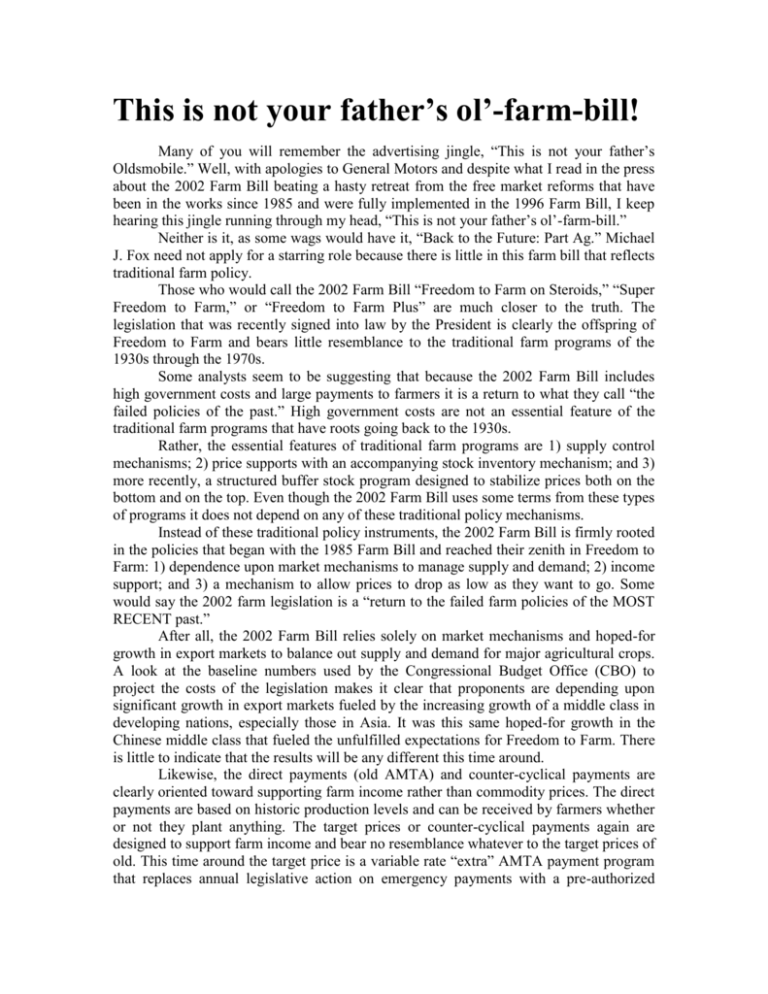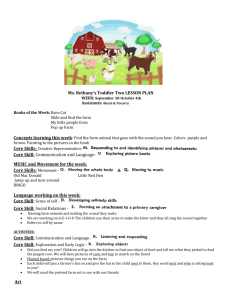This is not your fathers` old-farm bill
advertisement

This is not your father’s ol’-farm-bill! Many of you will remember the advertising jingle, “This is not your father’s Oldsmobile.” Well, with apologies to General Motors and despite what I read in the press about the 2002 Farm Bill beating a hasty retreat from the free market reforms that have been in the works since 1985 and were fully implemented in the 1996 Farm Bill, I keep hearing this jingle running through my head, “This is not your father’s ol’-farm-bill.” Neither is it, as some wags would have it, “Back to the Future: Part Ag.” Michael J. Fox need not apply for a starring role because there is little in this farm bill that reflects traditional farm policy. Those who would call the 2002 Farm Bill “Freedom to Farm on Steroids,” “Super Freedom to Farm,” or “Freedom to Farm Plus” are much closer to the truth. The legislation that was recently signed into law by the President is clearly the offspring of Freedom to Farm and bears little resemblance to the traditional farm programs of the 1930s through the 1970s. Some analysts seem to be suggesting that because the 2002 Farm Bill includes high government costs and large payments to farmers it is a return to what they call “the failed policies of the past.” High government costs are not an essential feature of the traditional farm programs that have roots going back to the 1930s. Rather, the essential features of traditional farm programs are 1) supply control mechanisms; 2) price supports with an accompanying stock inventory mechanism; and 3) more recently, a structured buffer stock program designed to stabilize prices both on the bottom and on the top. Even though the 2002 Farm Bill uses some terms from these types of programs it does not depend on any of these traditional policy mechanisms. Instead of these traditional policy instruments, the 2002 Farm Bill is firmly rooted in the policies that began with the 1985 Farm Bill and reached their zenith in Freedom to Farm: 1) dependence upon market mechanisms to manage supply and demand; 2) income support; and 3) a mechanism to allow prices to drop as low as they want to go. Some would say the 2002 farm legislation is a “return to the failed farm policies of the MOST RECENT past.” After all, the 2002 Farm Bill relies solely on market mechanisms and hoped-for growth in export markets to balance out supply and demand for major agricultural crops. A look at the baseline numbers used by the Congressional Budget Office (CBO) to project the costs of the legislation makes it clear that proponents are depending upon significant growth in export markets fueled by the increasing growth of a middle class in developing nations, especially those in Asia. It was this same hoped-for growth in the Chinese middle class that fueled the unfulfilled expectations for Freedom to Farm. There is little to indicate that the results will be any different this time around. Likewise, the direct payments (old AMTA) and counter-cyclical payments are clearly oriented toward supporting farm income rather than commodity prices. The direct payments are based on historic production levels and can be received by farmers whether or not they plant anything. The target prices or counter-cyclical payments again are designed to support farm income and bear no resemblance whatever to the target prices of old. This time around the target price is a variable rate “extra” AMTA payment program that replaces annual legislative action on emergency payments with a pre-authorized sliding scale mechanism to disperse the emergency payments. Again, note that farmers do not have to produce the crop in question to receive the payments. Some have contended that the reason the free market mechanisms do not work to adjust supply is the level of these income support payments. They argued for lower loan rates asserting that if these prices are too high they interfere with market signals, encouraging over-production. We believe that lower loan rates (and lower “decoupled” payments, since it all tends to be viewed the same by farmers) might reduce crop production slightly, but production would remain at near current levels since farmers have little incentive or inclination to voluntarily reduce their acreage. The new legislation also continues the use of Loan Deficiency Payments (LDPs) which provides no limit as to how far commodity prices can fall. The commodity portion of the 2002 Farm Bill contains none of the marks of a traditional farm bill that one could characterize as “your father’s ol’-farm-bill.” Rather, doesn’t it seem more like a “Son-of-Pat” (Roberts) Freedom to Farm II piece of legislation? Daryll E. Ray holds the Blasingame Chair of Excellence in Agricultural Policy, Institute of Agriculture, University of Tennessee, and is the Director of the UT’s Agricultural Policy Analysis Center. (865) 974-7407; Fax: (865) 974-7298; dray@utk.edu; http://www.agpolicy.org. Reproduction Permission Granted with: 1) Full attribution to Daryll E. Ray and the Agricultural Policy Analysis Center, University of Tennessee, Knoxville, TN; 2) An email sent to hdschaffer@utk.edu indicating how often you intend on running Dr. Ray’s column and your total circulation. Also, please send one copy of the first issue with Dr. Ray’s column in it to Harwood Schaffer, Agricultural Policy Analysis Center, 310 Morgan Hall, Knoxville, TN 37996-4500.




